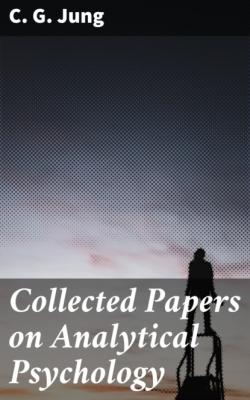ТОП просматриваемых книг сайта:
Collected Papers on Analytical Psychology. C. G. Jung
Читать онлайн.Название Collected Papers on Analytical Psychology
Год выпуска 0
isbn 4057664132208
Автор произведения C. G. Jung
Жанр Языкознание
Издательство Bookwire
Course 83
The progress of this affection reached its maximum in 4–8 weeks—Thenceforth a decline in the plasticity of the phenomena—All degrees of somnambulism were observable—Her manifest character improved—Similar improvements seen in certain cases of double consciousness—Conception that this phenomenon has a teleological meaning for the future personality—As seen in Jeanne d'Arc and Mary Reynolds II.
The Unconscious Additional Creative Work 84
S. W. shows primary susceptibility of the unconscious—Binet affirms the susceptibility of the hysteric is fifty times greater than that of normal—Cryptomnesia, a second additional creation—Cryptomnesic picture may enter consciousness intra-physically—Unconscious plagiarism explained—Zarathustra example—Glossolalia—Helen Smith's Martian language—The names in Ivenes' mystic system show rudimentary glossolalia—The Cryptomnesic picture may enter consciousness as a hallucination—Or arrive at consciousness by motor automatism—By automatisms regions formerly sealed are made accessible—Hypermnesia—Thought-reading a prototype for extraordinary intuitive knowledge of somnambulists and some normal persons—Association-concordance—Possibility that concept and feeling are not always clearly separated in the unconscious—S. W.'s mentality must be regarded as extraordinary.
The Association Method 94
Lecture I.—Formula for test—Disturbances of reaction as complex-indicators—Discovery
of a culprit by means of test—Disturbances of reaction show emotional rather than intellectual causes—Principal types—Value of the experiment in dealing with neurotics.
Lecture II.—Familiar Constellations 119
Dr. Fürst's researches—Effect of environment and education on reactions—Effect of parental discord on children—Unconscious tendency to repetition of parental mistakes—Case of pathological association-concordance between mother and daughter—Neurosis, a counter-argument against the personality with which the patient is most nearly concerned—How to free the individual from unconscious attachments to the milieu.
Lecture III.—Experiences concerning the Psychic Life of the Child 132
Importance of emotional processes in children—Little Anna's questions—Arrival of the baby brother—Anna's embarrassment and hostility—Introversion of the child—Of the adolescent—Her pathological interest in the Messina earthquake—The meaning of her fear—Anna's theories of birth—Meaning of her questions—Her father tells her something of origin of her little brother—Her fears now subside—The unconscious meaning of the child's wish to sit up late—Anna's equivalent to the "lumpf-theory" of little Hans—The stork-theory again—Author's remarks on the sexual enlightenment of the child.
The Significance of the Father in the Destiny of the Individual 156
Psychosexual relationship of child to father—Fürst's experiments quoted—The association experiment typical for man's psychological life—Adaptation to father—Father-complex productive of neurosis—Father-complex in man with masochistic and homosexual trends—Peasant woman "her father's favourite," tragic effect of the unconscious constellation—Case of eight-year-old boy with enuresis—Enuresis a sexual surrogate—Importance of infantile sexuality in life—Hence necessity for psychoanalytic investigation—The Jewish religion and the father-complex—Parental power guides the child like a higher controlling fate—The conflict for the development of the individual—Father-complex in Book of Tobias.
A Contribution to the Psychology of Rumour 176
Investigation of a rumour in a girls' school—The rumour arose from a dream—Teacher's suspicions—Was the rumour an invention and not, as alleged, the recital of a dream?—Interpolations in dreams—Collection of evidence—Duplication of persons an expression of their significance both in dreams and in dementia præcox—The additions and interpolations represent intensive unconscious participation—Hearsay evidence—Remarks.
Epicrisis 188
The dream is analysed by rumour—Psychoanalysis explains the construction of rumour—The dream gives the watchword for the unconscious—It brings to expression the ready-prepared sexual complexes—Marie X.'s unsatisfactory conduct brought her under reproof—Her indignation and repressed feelings lead to the dream—She uses this as an instrument of revenge against the teacher—More investigation needed in the field of rumour.
On the Significance of Number-Dreams 191
Symbolism of numbers has acquired fresh interest from Freud's investigations—Example of number dream of middle-aged man—How the number originates—A second dream also contains a number—Analysis—The wife's dream "Luke 137"—This dream is an example of cryptomnesia.
A Criticism of Bleuler's "Theory of Schizophrenic Negativism" 200
Bleuler's concept of ambivalency and ambitendency—Every tendency balanced by its opposite—Schizophrenic negativism—Bleuler's summary of its causes—The painfulness of the complex necessitates a censorship of its expression—Thought disturbance the result of a complex—Thought pressure due to schizophrenic introversion—Resistance springs from peculiar sexual development—Schizophrenia shows a preponderance of introversion mechanisms—The value of the complex theory concept.
Psychoanalysis 206
Doctors know too little of psychology, and psychologists of medicine—Strong prejudice aroused by Freud's conception of the importance of the sexual moment—The commoner prejudices discussed—Psychoanalysis not a method of suggestion or reasoning—The unconscious content is reached via the conscious—Case of neurotic man with ergophobia for professional work—Case of neurotic woman who wants another child—Resistances against the analyst—Dream analysis the efficacious instrument of analysis—The scientist's fear of superstition—The genesis of dreams—Dream material is collected according to scientific method—The rite of baptism analysed—When the unconscious material fails, use the conscious—The physician's own complexes a hindrance—Interpretations of Viennese School too one-sided—Sexual phantasies both realistic and symbolic—The dream the subliminal picture of the individual's present psychology—Symbolism a process of comprehension by analogy—Analysis helps the neurotic to exchange his unconscious conflict for the real conflict of life.
On

